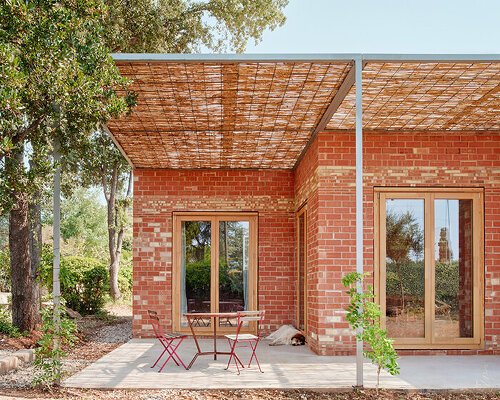casa GJ responds to its catalan site
Casa GJ, designed by Alventosa Morell Arquitectes, occupies a flat corner plot in Matadepera, a quiet town at the base of the Catalan mountains. Built for a young couple on a piece of land that once belonged to their extended family, the residential project introduces a modular, brick architecture that balances shared living with privacy and long-term adaptability.
The 600-square-meter site is south-facing and framed by two existing detached homes. A few mature trees remain on the property, integrated carefully into the architectural scheme. From the outset, the clients requested a house that would feel open and connected while still offering secluded zones for privacy and future flexibility.
Responding to these parameters, the team organizes the project as a series of nine identical modules. These volumes are arranged along a staggered east-west axis, carefully positioned to preserve the site’s trees and maximize the number of south-facing rooms. The linear layout gently shifts as it moves across the site, creating small courtyards and moments of visual permeability.
images © José Hevia
a modular layout by Alventosa Morell Arquitectes
The internal structure of the Alventosa Morell Arquitectes-designed Casa GJ relies on the spatial potential of its modules. The architects plan each room to open to at least two others, allowing a fluid progression through the home. The staggered arrangement produces cross-views and dynamic relationships between interior and exterior, where no single room is fully enclosed nor entirely exposed. A central module anchors the plan, rising slightly above the others to capture winter sun and channel natural ventilation during warmer months.
This center of gravity helps balance the home’s passive thermal strategies. The project achieves climate control through a combination of orientation, solar exposure, cross-ventilation, and thermal mass rather than mechanical systems. The result is a spatial experience shaped as much by air and light as by walls and ceilings.
Casa GJ is located in Matadepera, a town at the foot of the Catalan mountains
a brick structure designed for permanence
Casa GJ’s structure is designed by Alventosa Morell Arquitectes with load-bearing brick walls, concrete floors, and a roofscape of shallow vaults that echo traditional Catalan construction. The simplicity of materials lends the house a tactile, grounded presence, with thermal inertia playing a key role in maintaining indoor comfort across seasons.
The decision to work with brick and concrete reflects a desire for permanence, minimal maintenance, and performance. These elements are complemented by pergolas that extend the modular grid into the garden, forming shaded outdoor rooms that echo the rhythm of the interiors.
Each module opens to the landscape with carefully placed windows and thresholds. The outdoor pergolas provide gradual transitions between built space and vegetation, offering climatic buffering while reinforcing a sense of continuity between inside and out. These planted structures encourage daily interaction with the natural environment, providing shade in summer and filtered light in winter.
the house is built for a young couple on a property with mature trees preserved on site
Alventosa Morell Arquitectes arranges nine identical modules along a staggered axis
the modular layout allows for both privacy and shared living
the structure comprises brick load-bearing walls, concrete flooring, and vaulted ceilings
interior spaces connect fluidly to one another with framed views and shifting alignments
the central module rises to increase winter sun and improve cross-ventilation in warmer months
project info:
name: Casa GJ
architect: Alventosa Morell Arquitectes | @alventosamorell
location: Matadepera, Spain
design team: Marc Alventosa, Xavier Morell
area: 142 square meters
completion: 2024
photography: © José Hevia
The post catalan studio alventosa morell shapes casa GJ with staggered modules of textural brickwork appeared first on designboom | architecture & design magazine.

